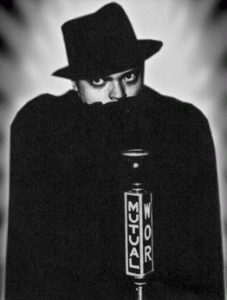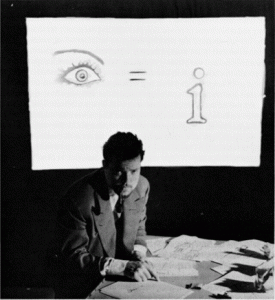 How do you narrow down the mystery that is Orson Welles? Like trying to make a disc of the greatest sounds of the planet earth, really, it’s fairly impossible to do, yet fun to try. We can bask in the warm glow of Citizen Kane and marvel that it was made; gnash our collective teeth at the wonton destruction of The Magnificent Ambersons, Touch of Evil, Lady from Shanghai, or shake our heads at the brilliant lunacy of F for Fake. Oh, yes, and in-between, there’s Shakespeare films, and somewhere, floating between here and the Shah of Iran is his last movie, the Other Side of the Wind.
How do you narrow down the mystery that is Orson Welles? Like trying to make a disc of the greatest sounds of the planet earth, really, it’s fairly impossible to do, yet fun to try. We can bask in the warm glow of Citizen Kane and marvel that it was made; gnash our collective teeth at the wonton destruction of The Magnificent Ambersons, Touch of Evil, Lady from Shanghai, or shake our heads at the brilliant lunacy of F for Fake. Oh, yes, and in-between, there’s Shakespeare films, and somewhere, floating between here and the Shah of Iran is his last movie, the Other Side of the Wind.
Orson revolutionized theater. Radio. Movies. The few bits he had on TV suggest that would have been his catnip as well. F for Fake predates and out-maneuvers documentarians like Errol Morris. But try to write a biography of the man, and, well, you get conflicting stories. Like Mr. Arkadin based on the novel Confidential Report, written by Orson Welles.
Only he didn’t. Write it, that is. Who did. Who knows? That’s one of the many mysteries of Orson Welles. Exaggeration. Hyperbole. Duplicity. Fraud. Aggrandizement. Trickery. Legerdemain. Magic. Yes. That’s it–magic.
Oh, I’ve tried to write about Welles. I’ve tried to speak about Welles. I’ve read books, articles, websites, you name it, I’ve plumbed the depths of the mystery. And I don’t know what to say except that I’ll keep on reading and wondering, for just as you keep trying to make sense of an amazing magic trick, and know–know!–it’s a falsehood, well, you keep coming back for more.
His movies are brilliant. You can bat around the claim that Kane is the greatest film of all time as if it were some kind of a trademark, but really that claim keeps people at bay, keeps them from seeing the joy and the humor of that lively film. Though, it could be claimed that without Kane you don’t have film noir. That in itself, well, I hesitate to add to the hyperbole…
Welles liked to spin tales. That’s what he did, onscreen, on the air, on stage. His brilliance lay not in trying to conjure up a bunch of technical geegaws to wow an audience. Rather, Welles sought desperately to use technology to further his story, to make it more real, more engaging.
Again, consider Kane. So much is made about Welles’ massive ego, but he knew that cinematographer Gregg Toland was as much of an influence as he himself was. Toland created the “look” of Kane, the angles, the shadows, and, perhaps most importantly, the deep-focus that went on to influence generations of filmmakers. Welles shared a title card with Toland. Tell me again what other director has shared a title card? With anyone, much less a cinematographer.
Welles’ army of biographers rarely come to agreements. Jonathan Rosenbaum once noted that the most outrageous stories, the craziest and most easy to disprove, turn out to be true. Personally, I’ve discovered that an old tale about Welles’ discovering a paperback that he eventually turned into The Lady From Shanghai, and later disproved, might have been true–the claim is that there was never a paperback copy of the book prior to 1960… and yet I found one from 1953.
The great interviews that Peter Bogdonovich had with Welles are so full of the big man’s tales you just have to laugh… until you discover they’re not tales. And of course some are utter bullshit. Yet so convincing that some of the people who were witness changed their stories to match his. Which makes for a great magic trick.
That’s Welles’ life, isn’t it? Mystery and cunning and magic. Look, look here, he says, waving a white-gloved hand over The Magnificent Ambersons and making you feel as if he took responsibility for its destruction, that he ignored his masterpiece and forced the studio to cut the thing in half. Then later, a tap, tap, tap of a wand on the edge of a black top hat, and Orson pulls out a copy of a cable he sent to RKO, proving he tried to make contact with the studio with full instructions on how to edit. Pulled from his sleeve is the text to Confidential Report and then, poof! It vanishes again behind a mirror.
Welles fans like myself live in a state of constant aggravation hoping against hope that lost chunks of Ambersons and Lady From Shanghai surface, just as we hope the supposed restoration of The Other Side of the Wind eventually gets finished.
But just as we know the lady was never really sawed in half, or that the rabbit never really disappeared, we also know that those dreams will not come true. The pictures we have are the pictures we have. And I thank the man for keeping the story interesting. All these years after his death, there’s still new stories tumbling about. That, my friends, is magic.
George Orson Welles was born May 6, 1915 in Kenosha, Wisconsin and died October 10, 1985 in Hollywood, California.

